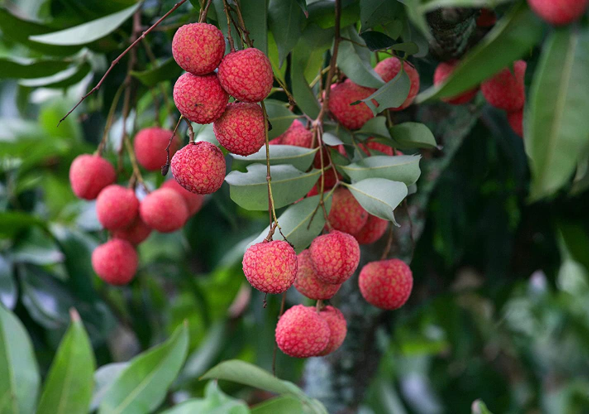Litchi chinensis
Overview
Lychee is the sole member of the genus Litchi in the soapberry family. It is a tropical tree native to southern China. This tree has been introduced to Southeast Asia and South Asia. Cultivation of lychee in China has been documented since the 11th century. The lychee tree is a tall evergreen tree, and its fruit is fleshy and sweet, enclosed in a pink, rough-textured rind. However, lychee seeds contain methylene cyclopropyl glycine, and experiments have shown that consumption of lychee fruit by some undernourished children in India and Vietnam can lead to hypoglycemic encephalopathy.

Geographical Distribution
Lychee is extensively cultivated in southern China, Taiwan, Vietnam, and other tropical regions of Southeast Asia, as well as the Indian subcontinent and many other countries and regions with tropical climates.
In China, lychee is mainly grown within the latitude range of 18-29 degrees north. The most cultivation occurs in Guangdong, followed by Fujian and Guangxi. There is also some cultivation in provinces such as Sichuan, Yunnan, Chongqing, Zhejiang, Guizhou, and Taiwan. Lychee is also cultivated in Southeast Asian countries, and there are records of its introduction to Africa, the Americas, and Oceania.
Guangdong province has the highest distribution of lychee cultivation in China, with over 80 counties and cities across the province engaged in cultivation. The Nanshan District of Shenzhen, Guangdong, is known for its red sandy loam soil, maritime climate, and unique geographic environmental conditions, which contribute to the production of lychee with characteristics such as clear and translucent flesh, crispness, and a sweet taste.
Application
- Edible use: Lychee is renowned as the "king of all fruits" and holds great cultural significance in China. It is widely consumed and enjoyed for its delicious taste and refreshing texture.
- Healthcare: The "Compendium of Materia Medica" recorded various health benefits associated with lychee, including its positive effects on the liver, spleen, and qi. It is believed to have blood-warming properties and can alleviate pain. Additionally, lychee is considered to have a calming effect on the heart and mind, promoting tranquility. It is known to regulate qi, disperse discomfort, and even prevent diarrhea.
- Medicinal use: Pharmacological research has demonstrated the potential medicinal properties of lychee kernels. These kernels have been found to possess hypoglycemic and lipid-lowering effects, as well as antiviral properties. Furthermore, they have shown promise in protecting the liver from damage.
Genome sequencing
The resolution of the "Fei Zi Xiao" lychee genome was led by the South China Agricultural University in 2022. The researchers utilized technologies such as Illumina, PacBio, Hi-C, and others to sequence the reference genome, yielding a total of 362G of sequencing data. De novo assembly was conducted using long reads corrected with shotgun reads, generating a draft genome of 962 Mb with a contig N50 of 752 kb. The genome was assembled into 15 pseudochromosomes, and a total of 31,896 putative protein-coding gene models were predicted.
Reference
1.Spencer PS, Palmer VS. The enigma of litchi toxicity: an emerging health concern in southern Asia. Lancet Glob Health. 2017;5(4):e383-e384. [OpenLBID: OLB-PM-28153516]
2.董周永. 荔枝多糖的提取、分离纯化及抗氧化性研究[D]. 西北农林科技大学,2006.
3.卢美英,郭蔚,潘介春,等. 世界荔枝龙眼生产贸易分析及应对措施[J]. 世界农业,2004(8):23-26. DOI:10.3969/j.issn.1002-4433.2004.08.007.
4.陈衍斌,武可泗,顾宜,等. 荔枝核化学成分及药理研究概况[J]. 中国中医药信息杂志,2007,14(5):97-98. DOI:10.3969/j.issn.1005-5304.2007.05.056.
5.蓝勇. 中国西南荔枝种植分布的历史考证[J]. 中国农史,1988(3):68-76.
6.赵荣芳,陈惠阳,谢勇,等. 广东省主要水果种植面积和产量发展历史与现状分析[J]. 安徽农学通报,2013(18):60-63,66. DOI:10.3969/j.issn.1007-7731.2013.18.031.
7.SK Mitra. Overview of lychee production in the Asia-Pacific region. Food and Agricultural Organization of the United Nations, Office for Asia and the Pacific. Retrieved 12 June 2020.
8.Mitra S K. Overview of lychee production in the Asia-Pacific region[J]. Lychee Production in the Asia Pacific Region. Food and Agricultural Organization of the United Nations, Bangkok, Thailand, 2002: 5-13.
9.Hu G, Feng J, Xiang X, et al. Two divergent haplotypes from a highly heterozygous lychee genome suggest independent domestication events for early and late-maturing cultivars. Nat Genet. 2022;54(1):73-83. [OpenLBID: OLB-PM-34980919]
| Data Statistics | |
|---|---|
| Taxonomy ID | 151069 |
| Projects | 11 |
| Samples | 300 |
| Genomes | 1 |
| Variations | 26,997,640 |
| Expressions | 10 |
| Reference | lychee_FZX |
| Refgenes | 31,896 |
| Cultivars | 91 |